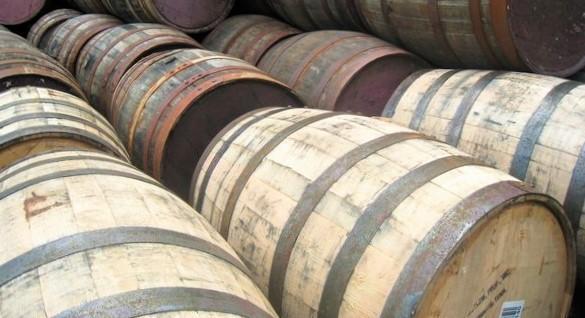Americans, of course, are renowned for their love of new things, so the fact that their law demands that bourbon must always be matured in new barrels should come as no surprise. Nor will it surprise those familiar with the Scottish reputation of being, shall we say, careful with money that Scotch whisky barrels are always second-hand.
Traditionally, 500-litre sherry casks called butts have been used. But these, according to David Robertson, the master distiller at Macallan's, on Scotland's famous (to whisky-lovers) river Spey, became scarce during the Spanish Civil War of the 1930s. That was when many Scotch distilleries, though not Mr Robertson's, turned their eyes to Kentucky as a source of alternatives.
Liquid-gold mine: Frankfort, KentuckyCorbis
Second-hand goods, of course, are always a little worn—and second-hand barrels are no exception since they have had some of their chemical vims and vigor sucked out of them. According to Lincoln Henderson, Labrot & Graham's master distiller, the new barrels are responsible for roughly 80% of his bourbon's final character and flavor.
By contrast, Bill Lumsden, Glenmorangie's head of distilleries and maturation, reckons his used bourbon casks are responsible for only 60% of his whisky's flavor and character. This difference is exactly as it should be; most Scottish distillers don't want new barrels since the wood flavors would overpower their distillate's character.
At the same time, many distillers are coming to see the value of introducing different woods into the maturation process. Some have taken to "finishing" their whisky in different casks for a year or two to modify the flavor. The Glenlivet 12-year-old, for example, is available in a variant that has been finished in a barrel made from Limousin oak, Quercus robur, from France. Limousin oak, used to mature cognac, contains a different spectrum of chemicals from Quercus alba, and this difference is discernible in the taste.
St. George Spirits, an American distillery well-versed in eaux de vie, recently produced its first single malt whisky. During maturation, it used a combination of barrels. Some 82% of the spirit was matured in used bourbon barrels, 12% in new French oak ones, and 6% in former port casks, allowing the mingled compounds from the barrels' wood and any previous liquid inhabitants to each make their particular contribution to the finished whisky.
Past its best, by now, alasMary Evans
Maturation, too, differs between America and Scotland. Although Scotch can legally be sold once it is three years old, few serious drinkers would touch such a youthful spirit. In Scotland, not mere years but decades add distinction. That is essentially to do with the climate. As an experiment, Maker's Mark swapped barrels with a Scottish distiller to see how much the environments of the two places affected the whisky's maturation.
The experiment's outcome was that one year in Kentucky, with its hot summers and cold winters, was roughly equivalent to four in Scotland, with its much more consistent and humid climate. However, even minor environmental differences can produce marked results. As Buffalo Trace's president, Mark Brown, points out, one of the distillery's distinctive bourbons, Blanton's, comes exclusively from casks matured in the firm's only metal-sided warehouse. The other warehouses are brick buildings with very different thermal characteristics, yielding different-tasting bourbon.
Share This Article on Social Media


